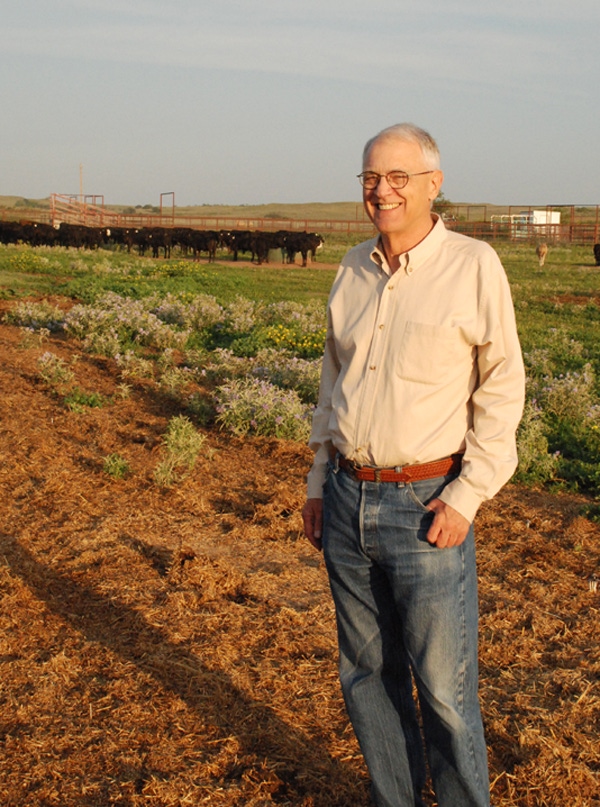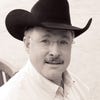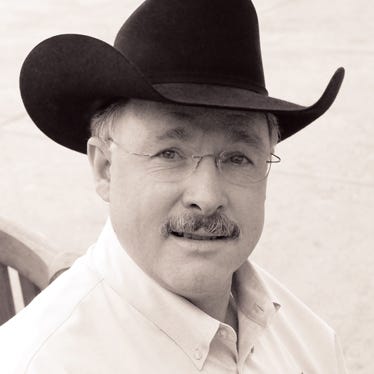Jay O’Brien Is 2013 BEEF Stocker Award Winner
Grazing and growing cattle is essential to achieving the primary mission of the ranches Jay O’Brien owns and manages: to care for the land and create a sustainable profit.
September 30, 2013

“You own stocker cattle long enough and the market generally gives you a chance to come out on them.” -- Jay O'Brien
“You own stocker cattle long enough and the market generally gives you a chance to come out on them,” says Jay O’Brien of Amarillo, who owns a ranch northeast of Clarendon, TX, with his children and grandkids. He also manages ranches in Texas and Colorado.
“Yearlings have been really good to us over a lot of years,” O’Brien explains. “The stocker business has been the most profitable sector during my time.”
The game has changed, though.
“We used to buy large numbers of cattle weighing less than 350 lbs.,” O’Brien says. “There were weeks we could bring in 1,000-2,000 head. I’m not sure you could find that many light calves in a week now, even if price wasn’t a factor.
“Our job then was to double their weight or more, and do it cheaply enough to make money. We do the same thing now, except we can’t double the weight.”
Another major difference, according to O’Brien, is the health of the cattle.
“In my arrogant youth, I thought we were buying higher-risk cattle cheap enough that we were getting a better return, because our management system and effort mitigated the risk,” O’Brien explains. “In the last decade, I’ve had that arrogance absolutely knocked out of me.”
Referring to put-together cattle gathered in the Southeast and then making the long haul to the Texas Panhandle, O’Brien says, “I can’t do a good enough job keeping them alive like we used to. We don’t have the tools to handle the health on the calves we used to. The medications aren’t as effective as they were.”
It could be the heavier cattle at younger ages, genetics, different bugs, the pharmaceuticals used, a combination of these and other factors. All O’Brien knows for sure is that he’d like to go back to the days when a 3% death loss on high-risk calves was considered a wreck.
Longer-acting medicines have changed O’Brien’s management, too.
“How we handle our health programs has changed substantially and made our job more difficult,” O’Brien says. “The old theory was you’d get calves in, they’d go through the sweats and break in 10 days. In 21 days, they were ready to go to pasture. With the newer, longer-acting drugs, a lot of times the cattle won’t break until 21 days. It changes how you manage them, and it costs more.”
Plus, cattle are on a receiving ration longer, and they remain in receiving traps longer, meaning fewer head can be handled in the same period of time.
But changes bring opportunity, too. “The health challenge has added value to the role of the stocker operator,” O’Brien explains. “It’s harder for feedlots to straighten out calves, so that adds some value back.”
One way O’Brien is addressing the health challenge is buying calves in the Southeast and putting them on a 45-day preconditioning program before shipping them to his ranches.
Focusing on cattle handling helps, too. Years ago, O’Brien built catch pens in the corner of receiving traps so that sick cattle could be pulled with less stress, loaded onto a trailer, and taken to a sick pen.
“It helps us with death loss, sickness and gain, not stressing the entire group by roping calves to doctor like we did years ago. We didn’t know it at the time, but less stress in handling also helps us on grade,” O’Brien explains. He knows because he and his partners feed many of the calves they stocker.
“In the last 10 years, we’re absolutely looking for one-brand calves,” O’Brien says. “We don’t buy as many high-risk calves. We won’t hit a ranch with as many in a week as we used to, and we won’t mix sources. We’ve got enough cows that we don’t need to buy as many calves as we used to.”
Countercyclical procurement
One way Jay O’Brien addresses today’s health challenges with young calves is to buy them in the Southeast, then put them on a 45-day preconditioning program prior to shipping them west to his ranches. He says focusing on cattle handling helps as well.
Until the 1990s, the cattle inventory on O’Brien’s ranch and those he manages was virtually all stocker cattle. In the mid-’90s, buying some cows made countercyclical sense to him.
“Our theory was that we’d stock half of our country with cows and half with stockers,” O’Brien explains. “We were doing that partly as a safety play for drought — and economic safety, too.”
The decision proved more than wise the last couple of years amid the historic drought in the Southwest. Stocker cattle provided the necessary shock absorber to maintain their cow herds.
“Early in summer 2011, we destocked and took our yearling cattle to the feedlot,” O’Brien explains. “In 2012, we didn’t buy any stockers for our Texas or New Mexico ranches.
“Because we destocked so early, we had extra grass, so we bought some cows that were equivalent to stockers for us. With the prices they were bringing, if we needed to destock those, they looked to be more profitable than light steers.”
They kept those stocker cows separate from the breeding herds. O’Brien also keeps cowherds from contact with any Mexican stocker cattle they run. “In a lot of our country, if we ever found a reactor [TB] and had to test cows, it would be a nightmare trying to gather and test them,” he says.
O’Brien’s own ranch, affectionately referred to as The Swamp, and the Martinez Ranch next to it — which he also manages — offer a glimpse to the country in his care. Though beautiful, it’s rough.
Moisture this summer means O’Brien has begun reloading with stocker calves, albeit at a slower pace than normal, but it does nothing to change wheat-pasture trends.
“Wheat pasture was a large part of our stocker operation for a number of years,” O’Brien explains. “We ran more cattle on wheat than grass, and wheat was more profitable for us on a per-pound and per-head basis.”
As grain prices headed north in recent years, fewer wheat growers were eager to make wheat pasture available. Even if that changes down the road, O’Brien says it will be a transition made over time rather than a sudden largesse of the forage.
With less wheat pasture, O’Brien buys cattle in the fall and dry-winters them through to the next summer. It’s increased his costs and cut the number of head he can run. “Like everyone else, we’re trying to figure out what will work,” he says.
Knowing rather than guessing
“If I have data, then I can evaluate my decisions,” O’Brien explains. “I wanted the data so that once I’d paid my tuition in the business, I could use it and not have to keep paying tuition. Knowing how a ranch’s cattle performed the last time I fed them enabled me to buy better cattle.”
He’s alluding to the reason he taught himself to write ranch management software in the mid-1970s, when many others were still questioning whether there was a future for those massive, humming piles of metal called computers. O’Brien wanted profit books rather than just cash accounting. He wanted to know.
Knowing rather than guessing is one reason he’s long advocated mandatory individual animal ID, something he’s used to manage cows and stocker cattle in his operations for years. He championed the cause as president of the Texas Cattle Feeders Association (TCFA) more than two decades ago.
Incidentally, O’Brien’s record of industry volunteer service reads like a how-to manual for “Who’s Who.” In addition to TCFA, a short list includes extensive involvement and key leadership positions with the Cattlemen’s Beef Board, Texas Beef Council and the National Cattlemen’s Beef Association.
Besides the management information enabled by individual ID, O’Brien believes the Eastern Livestock financial debacle would have never happened to the extent it did had mandatory individual ID been used as a way to carry title.
“If ID was mandatory at the point of first transfer, it could be connected to ownership like a Vehicle Identification Number for a pickup or tractor. A lien could be placed against it. When you sold the cattle, the lien would have to be paid before ownership could change. No one could double-mortgage cattle; buyers would have to pay off the original owner,” he explains.
Plus, O’Brien believes it would provide an impediment against livestock theft, as well as helping control a catastrophic disease outbreak.
“I don’t see a downside to it, and the upside is monstrous,” O’Brien says. “It would offer so many benefits — but we’re letting the paranoid, black-helicopter crowd keep the industry from moving that direction.”
In his mind, the primary argument raised by opponents revolves around a fear of liability: that a problem could be traced back to the ranch.
“What would scare me worse than finding out I had a disease problem on my ranch would be having a disease problem I didn’t know about,” O’Brien says.
Partnerships fuel his cattle career
Coming out of the price-freeze wreck in 1973, O’Brien was buying and selling lots of yearlings out front, trying to make money on the basis. He was also managing a lot of cattle on feed for a lot of other folks.
O’Brien and Teel Bivins understood that feeding cattle at that time provided an attractive tax shelter due to a loophole in the tax code. There were strict limitations on how that could be accomplished, though. Long story short, armed with the management capability of O’Brien’s software, the pair formed an untold number of partnerships for a bevy of investors.
Managing lots of cattle offered other advantages, too. For instance, the large numbers of cattle on feed they controlled allowed them to trade for feed discounts with the yards where the cattle were being fed.
Even before that, O’Brien was partnering with Bivins on different deals. That led to O’Brien partnering up with Teel and his brother Tom to manage the Bivins’ family ranch north of Amarillo, TX.
“They wanted to run cattle on their ranch in a way that would improve the asset while creating a sustainable profit,” O’Brien explains. “That’s basically the mission statement for all of the ranches I manage: Care for the land and create a sustainable profit.”
That initial partnership, one enduring more than four decades so far, sowed the seeds for subsequent ones, including O’Brien’s ongoing management of the storied JA Ranch.
“The thing I’m proudest of is that we’ve continued all these partnerships over the years without a falling-out, because we all have the same motives and incentives for the long haul,” O’Brien says.
Since 1997, O’Brien says Dale Smith, of Amarillo, has been a full partner in all of his cattle ventures and ranch management.
Even though the owners of the ranches O’Brien manages are uninvolved in the day-to-day management, he and Smith make communicating with them a priority in order to avoid misunderstandings. And, O’Brien explains, “Someone questioning you is almost always beneficial.”
For O’Brien, stocker cattle continue to be a key answer to the question of improving the ranches in his care while cleaving a sustainable profit.
“The opportunity is that you have a resource in forage that basically has no other beneficial use than turning it into beef. You can do that with stockers or with cows,” O’Brien reflects. “If you don’t put cattle on it, you don’t have a way to get paid anything for the grass.”
Cattle trump law degree
O’Brien had a seat waiting for him at the University of Texas Law School following his 1967 graduation from Yale University. Then he got to trading cattle.
Specifically, O’Brien explains, “Tom Reid was buying lots of fat cattle for Southeast packers. He hired me to drive him, and cut me in on the deals.”
O’Brien was fascinated. Until that point, his cattle experience was spending his summers working on the commercial Hereford ranch in eastern New Mexico owned by his dad’s family. Not much there sparked his enthusiasm.
Next, O’Brien briefly worked for Eugene Schwertner and Capitol Cattle Co. “I got to see lots of different cattle going lots of different ways,” he says.
He partnered with his brother, Bill, who also runs cattle over wide swaths of country. He was feeding cattle, too, but he says there wasn’t enough to keep him occupied.
At a Texas Cattle Feeders Association convention, O’Brien ran into Champ Gross of CALF News. Gross said he needed to hire a writer and asked O’Brien for prospects.
O’Brien thought the job would allow him to visit with and learn from some of the bright minds in the business. He also needed the money — so he told Gross he was interested. Despite his misgivings, Gross said OK, and O’Brien ended up writing for Gross for several years.
Among the lessons gleaned, O’Brien remembers visiting with Jack Carruthers following the 1973 cattle wreck.
“All the gurus were saying the market would stay bad forever,” O’Brien recalls. “Jack had the audacity to tell me that, due to the large number of calves on feed at the time, we were about to hit a bull market that would astound me. We proceeded to have one of the best bull markets we’d ever seen.”
O’Brien, like many, didn’t bet as optimistically. “Nothing teaches you like when you’re wrong. Stupid is forever,” he says.
The lesson he learned, though, is that “there’s a real place in the industry for contrarians, market-wise. If everyone is convinced something is going to happen, it probably isn’t.”
And at least a first cousin to that notion, O’Brien says, is “What’s easy is often the least profitable.”
You might also like:
A Time Capsule Of 50 Years Of BEEF Magazine Coverage
8 Surprising Factors That Impact Auction Prices For Beef Calves
It's Not Voodoo! Veterinary Acupuncture Can Be A Helpful Tool For Beef Producers
Temple Grandin Explains Animal Welfare Problems With Beta-Agonists
About the Author(s)
You May Also Like




.png?width=300&auto=webp&quality=80&disable=upscale)
